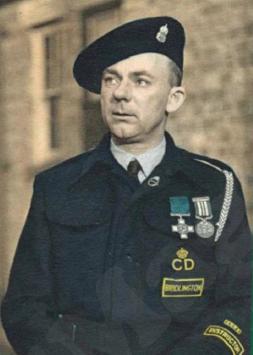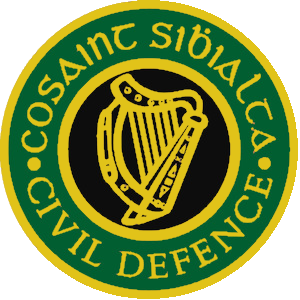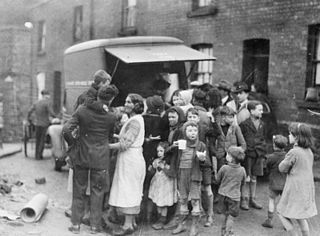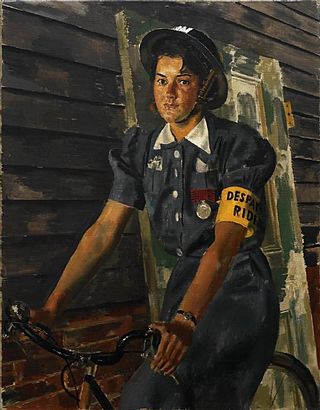
Civil defense or civil protection is an effort to protect the citizens of a state from human-made and natural disasters. It uses the principles of emergency operations: prevention, mitigation, preparation, response, or emergency evacuation and recovery. Programs of this sort were initially discussed at least as early as the 1920s and were implemented in some countries during the 1930s as the threat of war and aerial bombardment grew. Civil-defense structures became widespread after authorities recognised the threats posed by nuclear weapons.

The Blitz was a German bombing campaign against the United Kingdom, in 1940 and 1941, during the Second World War. The term was first used by the British press and originated from the term Blitzkrieg, the German word meaning 'lightning war'.

Air raid shelters are structures for the protection of non-combatants as well as combatants against enemy attacks from the air. They are similar to bunkers in many regards, although they are not designed to defend against ground attack.

A blackout during war, or in preparation for an expected war, is the practice of collectively minimizing outdoor light, including upwardly directed light. This was done in the 20th century to prevent crews of enemy aircraft from being able to identify their targets by sight, such as during the London Blitz of 1940. In coastal regions, a shoreside blackout of city lights also helped protect ships from being seen silhouetted against the artificial light by enemy submarines farther out at sea.

Thomas Hopper Alderson GC was a British Air Raid Precautions (ARP) warden in Bridlington, and the first person to be directly awarded the George Cross (GC) shortly after its creation in 1940.

The Civil Defence Service was a civilian volunteer organisation in Great Britain during World War II. Established by the Home Office in 1935 as Air Raid Precautions (ARP), its name was officially changed to the Civil Defence Service (CD) in 1941. The Civil Defence Service included the ARP Wardens Service as well as firemen, fire watchers, rescue, first aid post and stretcher parties. Over 1.9 million people served within the CD and nearly 2,400 lost their lives to enemy action.

The Reichsluftschutzbund was a civil defense organization in Nazi Germany in charge of air raid precautions in residential areas and among smaller businesses.

The Royal Voluntary Service is a voluntary organisation concerned with helping people in need throughout England, Scotland, Wales and Northern Ireland. It was founded in 1938 by Stella Isaacs, Marchioness of Reading, as a British women's organisation to recruit women into the Air Raid Precautions (ARP) services to help in the event of War.

The Bangladesh Fire Service & Civil Defence (FSCD) is an emergency service that operates under the Security Services Division of the Ministry of Home Affairs in the People's Republic of Bangladesh. The department's primary objective is to provide critical public safety services, including fire protection, emergency medical care, and other essential services.

The Ministry of Home Security was a British government department established in 1939 to direct national civil defence, primarily tasked with organising air raid precautions, during the Second World War. The Ministry for Home Security was headed by Sir John Anderson, the Home Secretary and Minister of Home Security. The Ministry's responsibilities covered all central and regional civil defence organisations, such as air raid wardens, rescue squads, fire services, and the Women’s Voluntary Service. It was also responsible for giving approval to local ARP schemes and providing public shelters.

Civil Defence Ireland is the national civil defence organisation of Ireland. It is a statutory agency of the Irish Department of Defence and is administered by local authorities. It was established in 1951 in response to the threat of nuclear disaster posed by the atomic bomb following World War II. Today it is an emergency response and rescue agency whose purpose is to provide aid, assistance and relief in times of emergency or natural disaster. It may also support primary emergency response agencies namely the Garda Síochána, HSE National Ambulance Service, and local authority fire services when requested. Civil Defence Ireland consists almost entirely of volunteers, numbering 2500 as of May 2023.
Leonard James Miles GC was an Air Raid Precautions warden who was posthumously awarded a George Cross for the gallantry he showed in leaving his air raid shelter to warn others of a nearby unexploded bomb in Hainault in Essex on 21 September 1940. He was by trade a building contractor.

The United Kingdom took part in World War II from 3 September 1939 until 15 August 1945. At the beginning of the war in 1939, London was the largest city in the world, with 8.2 million inhabitants. It was the capital not just for the United Kingdom, but for the entire British Empire. London was central to the British war effort. It was the favourite target of the Luftwaffe in 1940, and in 1944-45 the target of the V-1 cruise missile, the V-2 rocket, and the unsuccessful V-3 "London gun".

The Swansea Blitz was the heavy and sustained bombing of Swansea by the German Luftwaffe from 19 to 21 February 1941. A total of 230 people were killed and 397 were injured. Swansea was selected by the Germans as a legitimate strategic target due to its importance as a port and docks and the oil refinery just beyond, and its destruction was key to Nazi German war efforts as part of their strategic bombing campaign aimed at crippling coal export and demoralizing civilians and emergency services.
Many countries around the world have civil defense organizations dedicated to protecting civilians from military attacks and providing rescue services after widespread disasters. In most countries, civil defense is a government-managed and often volunteer-staffed organization.

The Leeds Blitz comprised nine air raids on the city of Leeds by the Nazi German Luftwaffe. The heaviest raid took place on the night of 14/15 March 1941, affecting the city centre, Beeston, Bramley and Armley. The city was subjected to other raids during the Second World War, but they were relatively minor; only the March 1941 raid caused widespread damage, including to the city's museum and its artefacts.

Charity Anne Bick was a British civilian dispatch rider during the Second World War, and the youngest ever recipient of the George Medal, the United Kingdom's second-highest award for civilian bravery. She later served in the Women's Royal Air Force.

Cairns Control Room is a heritage-listed military building at Grafton Street, Cairns City, Cairns, Cairns Region, Queensland, Australia. It was built in 1942 by the Queensland Department of Public Works. It is also known as World War II Volunteer Defence Corps, Cairns Scout Hut, and Cairns Scout Shop. It was added to the Queensland Heritage Register on 16 April 2010.
Police Auxiliary Messengers (PAMS) were operational in the UK during World War 2. Young lads under the age of eighteen with their own bikes were employed by local police forces with the primary role of taking messages during and after air raids if telephone communication was not practicable.
Ita Ekpenyon (1899–1951) was a Nigerian teacher and actor who was also the only known black Air Raid Precautions (ARP) warden in the United Kingdom. Ekpenyon was a teacher in Nigeria but came to London to study law. A speaker of the Efik language, he contributed to a textbook that was used by colonial authorities in Nigeria. Ekpenyon later taught the language to American actor Paul Robeson, with whom he acted in the 1930s films Sanders of the River and King Solomon's Mines. When the Second World War broke out, being too old to serve in the military, he joined the ARP service as a warden. He recounted that some London residents regarded him as lucky because of the colour of his skin, but he also encountered casual racism. Ekpenyon witnessed foreign nationals being barred from one air raid shelter and intervened to persuade the occupants to admit the newcomers; the incident was made into an animated film in 2010. Ekpenyon wrote a memoir on his ARP service and also featured in wartime broadcasts to demonstrate the commitment of West Africans to the war effort. In 2021, a Lucy Worsley docudrama featured Ekpenyon's life. After the war, Ekpenyon gave up on his ambitions for a career in law and became a postman.
































